Classification of the Land Cover of a Megacity in ASEAN Using Two Band Combinations and Three Machine Learning Algorithms: A Case Study in Ho Chi Minh City
Abstract
1. Introduction
2. Materials
2.1. Study Area
2.2. Data
2.3. Data Preprocessing
3. Method
3.1. Back-Propagation Neural Network Algorithm (BPNN)
3.2. Support Vector Machine Algorithm (SVM)
3.3. Random Forest Algorithm (R.F.)
3.4. Classification Accuracy Verification
4. Results
4.1. Classification Results of the BPNN Algorithm
4.2. Classification Results of the SVM Algorithm
4.3. Classification Results of the R.F. Algorithm
4.4. Results of Comparison with Different Land Cover Classification Products
5. Discussion
5.1. Authenticity Comparison of Land Cover Classification Results for Different Band Combinations
5.2. Applicability Comparison of Land Cover Classification Results of Different Machine Learning Algorithms
5.3. Comparison of Classification Results with Other Land Cover Classification Products
6. Conclusions
Author Contributions
Funding
Data Availability Statement
Conflicts of Interest
Appendix A
| Ground Features | Band Combination 764 | Band Combination 543 | Position | Street View | Coordinates (Latitude, Longitude) |
|---|---|---|---|---|---|
| Built-up Area | 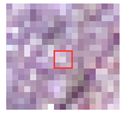 | 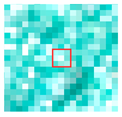 |  | 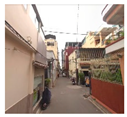 | 10.792473, 106.667262 |
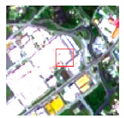 | 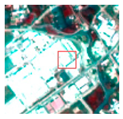 | 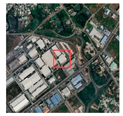 | 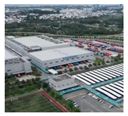 | 10.829346, 106.799270 | |
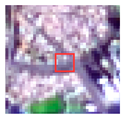 |  | 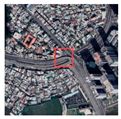 | 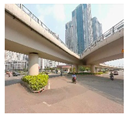 | 10.789532, 106.716194 | |
| Water | 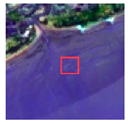 | 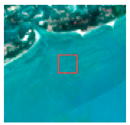 |  |  | 10.381218, 106.943331 |
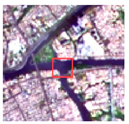 | 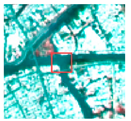 | 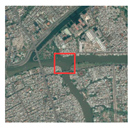 | 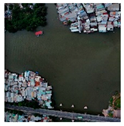 | 10.752191, 106.690308 | |
 | 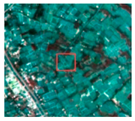 | 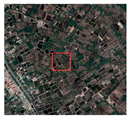 | 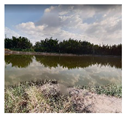 | 10.645197, 106.795583 | |
| Trees | 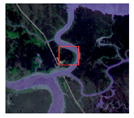 | 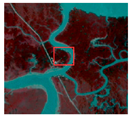 | 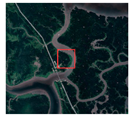 | 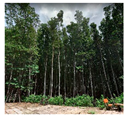 | 10.504798, 106.868985 |
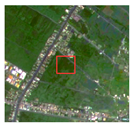 |  |  | 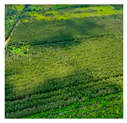 | 10.882809, 106.543391 | |
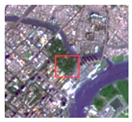 | 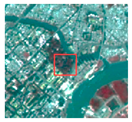 | 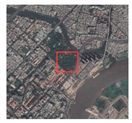 | 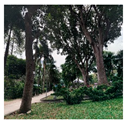 | 10.789399, 106.706238 | |
| Grass |  | 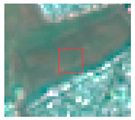 | 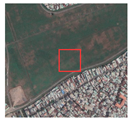 | 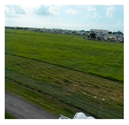 | 10.823842, 106.676173 |
 | 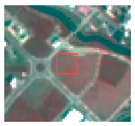 | 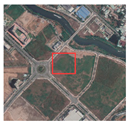 | 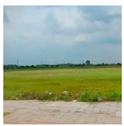 | 10.839985, 106.812435 | |
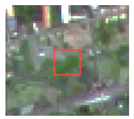 | 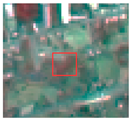 |  | 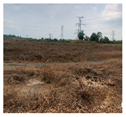 | 10.684276, 106.554909 | |
| Crops | 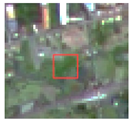 |  | 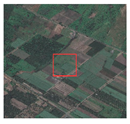 |  | 10.749396, 106.498723 |
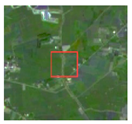 | 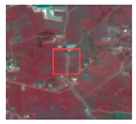 | 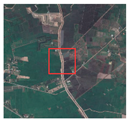 | 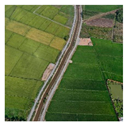 | 11.033259, 106.472815 | |
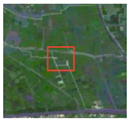 |  | 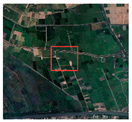 | 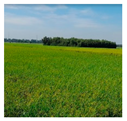 | 10.929771, 106.572075 | |
| Bare Ground | 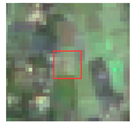 |  | 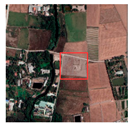 | 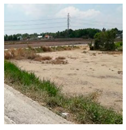 | 10.696127, 106.559957 |
 | 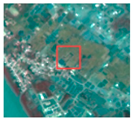 | 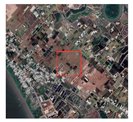 | 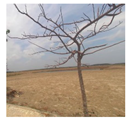 | 10.465401, 106.777864 | |
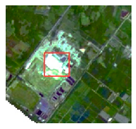 |  | 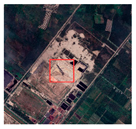 | 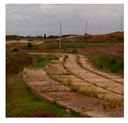 | 10.964576, 106.439237 |
References
- Gong, P.; Wang, J.; Yu, L.; Zhao, Y.C.; Zhao, Y.Y.; Liang, L.; Niu, Z.G.; Huang, X.M.; Fu, H.H.; Liu, S.; et al. Finer resolution observation and monitoring of global land cover: First mapping results with Landsat TM and ETM+ data. Int. J. Remote Sens. 2013, 34, 2607–2654. [Google Scholar] [CrossRef]
- Yang, J.; Gong, P.; Fu, R.; Zhang, M.H.; Chen, J.M.; Liang, S.L.; Xu, B.; Shi, J.C.; Dickinson, R. The role of satellite remote sensing in climate change studies. Nat. Clim. Chang. 2013, 3, 875–883. [Google Scholar] [CrossRef]
- Sun, C.; Koenig, H.J.; Uthes, S.; Chen, C.; Li, P.; Hemminger, K. Protection effect of overwintering water bird habitat and defining the conservation priority area in Poyang Lake wetland, China. Environ. Res. Lett. 2020, 15, 125013. [Google Scholar] [CrossRef]
- Chen, J.; Chen, J.; Liao, A.P.; Cao, X.; Chen, L.J.; Chen, X.H.; He, C.Y.; Han, G.; Peng, S.; Lu, M.; et al. Global land cover mapping at 30 m resolution: A POK-based operational approach. ISPRS J. Photogramm. Remote Sens. 2015, 103, 7–27. [Google Scholar] [CrossRef]
- Yu, L.; Wang, J.; Li, X.C.; Li, C.C.; Zhao, Y.Y.; Gong, P. A multi-resolution global land cover dataset through multisource data aggregation. Sci. China Earth. Sci. 2014, 57, 2317–2329. [Google Scholar] [CrossRef]
- Hashem, N.; Balakrishnan, P. Change analysis of land use/land cover and modelling urban growth in Greater Doha, Qatar. Ann. GIS 2015, 21, 233–247. [Google Scholar] [CrossRef]
- Zhao, Y.Y.; Feng, D.L.; Yu, L.; Wang, X.Y.; Chen, Y.L.; Bai, Y.Q.; Hernández, H.J.; Galleguillos, M.; Estades, C.; Biging, G.S.; et al. Detailed dynamic land cover mapping of Chile: Accuracy improvement by integrating multi-temporal data. Remote Sens. Environ. 2016, 183, 170–185. [Google Scholar] [CrossRef]
- Rahman, A.; Kumar, S.; Fazal, S.; Siddiqui, M.A. Assessment of land use/land cover change in the North-West District of Delhi using remote sensing and G.I.S. techniques. J. Indian Soc. Remote Sens. 2012, 40, 689–697. [Google Scholar] [CrossRef]
- Belward, A.S.; Estes, J.E.; Kline, K.D. The IGBP-DIS global 1-km land-cover data set discover: A project overview. Photogramm. Eng. Remote Sens. 1999, 65, 1013–1020. [Google Scholar]
- Chen, J.; Ban, Y.F.; Li, S.N. China: Open access to Earth land-cover map. Nature 2014, 541, 434. [Google Scholar] [CrossRef]
- Hansen, M.C.; Defries, R.S.; Townshend, J.G.R.; Sohlberg, R. Global land cover classification at 1 km spatial resolution using a classification tree approach. Int. J. Remote Sens. 2000, 21, 1331–1364. [Google Scholar] [CrossRef]
- China, Vietnam, and Indonesia Will Be among the Fastest-Growing Countries in the Coming Decade. Available online: https://phys.org/news/2022-07-china-vietnam-indonesia-fastest-growing-countries.html (accessed on 7 December 2022).
- The Story of Viet Nam’s Economic Miracle. Available online: https://www.weforum.org/agenda/2018/09/how-vietnam-became-an-economic-miracle/ (accessed on 8 December 2022).
- Phan, D.C.; Trung, T.H.; Truong, V.T.; Sasagawa, T.; Vu, T.P.T.; Bui, D.T.; Hayashi, M.; Tadono, T.; Nasahara, K.N. First comprehensive quantification of annual land use/cover from 1990 to 2020 across mainland Vietnam. Sci. Rep. 2021, 11, 9979. [Google Scholar] [CrossRef] [PubMed]
- Kontgis, C.; Schneider, A.; Fox, J.; Sakasena, S.; Spencer, J.H.; Castrence, M. Monitoring peri-urbanization in the greater Ho Chi Minh City metropolitan area. Appl. Geogr. 2014, 53, 377–388. [Google Scholar] [CrossRef]
- Volke, M.I.; Abarca-Del-Rio, R. Comparison of machine learning classification algorithms for land cover change in a coastal area affected by the 2010 Earthquake and Tsunami in Chile. Nat. Hazards Earth Syst. Sci. Discuss. 2020, 1–14. [Google Scholar] [CrossRef]
- Talukdar, S.; Singha, P.; Mahato, S.; Shahfahad, P.S.; Liou, Y.A.; Rahman, A. Land-use land-cover classification by machine learning classifiers for satellite observations—A review. Remote Sens. 2020, 12, 1135. [Google Scholar] [CrossRef]
- Mao, W.L.; Lu, D.B.; Hou, L.; Liu, X.; Yue, W.Z. Comparison of machine-learning methods for urban land-use mapping in Hangzhou city, China. Remote Sens. 2020, 12, 2817. [Google Scholar] [CrossRef]
- Rodriguez-Galiano, V.F.; Ghimire, B.; Rogan, J.; Chica-Olmo, M.; Rigol-Sanchez, J.P. An assessment of the effectiveness of a random forest classifier for land-cover classification. ISPRS J. Photogramm. Remote Sens. 2012, 67, 93–104. [Google Scholar] [CrossRef]
- Lefulebe, B.E.; Van der Walt, A.; Xulu, S. Fine-scale classification of urban land use and land cover with planetscope imagery and machine learning strategies in the city of Cape Town, South Africa. Sustainability 2022, 14, 9139. [Google Scholar] [CrossRef]
- Anderson, J.R. A Land Use and Land Cover Classification System for Use with Remote Sensor Data; U.S. Government Printing Office: Washington, DC, USA, 1976; Volume 964.
- Bui, Q.T.; Van, M.P.; Hang, N.T.T.; Nguyen, Q.H.; Linh, N.X.; Ha, P.M.; Tuan, T.A.; Cu, P.V. Hybrid model to optimize object-based land cover classification by meta-heuristic algorithm: An example for supporting urban management in Ha Noi, Viet Nam. Int. J. Digit. Earth 2019, 12, 1118–1132. [Google Scholar] [CrossRef]
- Goldblatt, R.; Deininger, K.; Hanson, G. Utilizing publicly available satellite data for urban research: Mapping built-up land cover and land use in Ho Chi Minh City, Vietnam. Dev. Eng. 2018, 3, 83–99. [Google Scholar] [CrossRef]
- Ha, T.V.; Tuohy, M.; Irwin, M.; Tuan, P.V. Monitoring and mapping rural urbanization and land use changes using Landsat data in the northeast subtropical region of Vietnam. Egypt. J. Remote Sens. Space Sci. 2020, 23, 11–19. [Google Scholar] [CrossRef]
- Nguyen, H.T.T.; Doan, T.M.; Tomppo, E.; McRoberts, R.E. Land use/land cover mapping using multitemporal Sentinel-2 imagery and four classification methods—A case study from Dak Nong, Vietnam. Remote Sens. 2020, 12, 1367. [Google Scholar] [CrossRef]
- Noi, P.T.; Kappas, M. Comparison of random forest, k-nearest neighbor, and support vector machine classifiers for land cover classification using Sentinel-2 imagery. Sensors 2017, 18, 18. [Google Scholar] [CrossRef]
- GADM. Available online: https://gadm.org (accessed on 6 December 2022).
- Viet Nam: Ha Noi and Ho Chi Minh City Power Grid Development Sector Project. Available online: https://policycommons.net/artifacts/387657/viet-nam/1352135/ (accessed on 8 December 2022).
- About the General Statistics Office (G.S.O.) of Viet Nam. Available online: https://web.archive.org/web/20220409040831/https://www.gso.gov.vn/en/about-gso/ (accessed on 6 December 2022).
- Foreign Direct Investment, Net Inflows (BoP, Current US$)—Vietnam. Available online: https://data.worldbank.org/indicator/BX.KLT.DINV.CD.WD?locations=VN (accessed on 7 December 2022).
- Landsat 8. Available online: https://www.usgs.gov/landsat-missions/landsat-8 (accessed on 8 December 2022).
- Google Earth Engine. Available online: https://earthengine.google.com/ (accessed on 8 December 2022).
- Tamiminia, H.; Salehi, B.; Mahdianpari, M.; Quackenbush, L.; Adeli, S.; Brisco, B. Google Earth Engine for geo-big data applications: A meta-analysis and systematic review. ISPRS J. Photogramm. Remote Sens. 2020, 164, 152–170. [Google Scholar] [CrossRef]
- Sentinel-2 10m Land Cover Time Series of the World. Available online: https://www.arcgis.com/home/item.html?id=d3da5dd386d140cf93fc9ecbf8da5e31 (accessed on 8 December 2022).
- GlobeLand 30. Available online: http://www.globallandcover.com/ (accessed on 7 December 2022).
- Lambin, E.F.; Geist, H.J. Land-Use and Land-Cover Change: Local Processes and Global Impacts; Springer Science & Business Media: Berlin, Germany, 2008. [Google Scholar]
- Yuan, F.; Sawaya, K.E.; Loeffelholz, B.C.; Bauer, M.E. Land cover classification and change analysis of the Twin Cities (Minnesota) Metropolitan Area by multitemporal Landsat remote sensing. Remote Sens. Environ. 2005, 98, 317–328. [Google Scholar] [CrossRef]
- Song, C.; Woodcock, C.E.; Seto, K.C.; Lenney, M.P.; Macomber, S.A. Classification and change detection using Landsat TM data: When and how to correct atmospheric effects? Remote Sens. Environ. 2001, 75, 230–244. [Google Scholar] [CrossRef]
- Band Combinations for Landsat 8. Available online: https://www.esri.com/arcgis-blog/products/product/imagery/band-combinations-for-landsat-8/ (accessed on 8 December 2022).
- Fakhira, R.; Cahyono, A. Mapping and analysis of built-up area development in Batam City from 2000 to 2015. In Proceedings of the Seventh Geoinformation Science Symposium 2021, Virtual, 25–28 October 2021; SPIE: Bellingham, WA, USA, 2021; Volume 12082, pp. 201–211. [Google Scholar] [CrossRef]
- Ji, L.; Zhang, L.P.; Shen, Y.; Li, X.; Liu, W.; Chai, Q.; Zhang, R.; Chen, D. Object-based mapping of plastic greenhouses with scattered distribution in complex land cover using Landsat 8 O.L.I. images: A case study in Xuzhou, China. J. Indian Soc. Remote Sens. 2020, 48, 287–303. [Google Scholar] [CrossRef]
- Oon, A.; Shafri, H.Z.M.; Lechner, A.M.; Azhar, B. Discriminating between large-scale oil palm plantations and smallholdings on tropical peatlands using vegetation indices and supervised classification of LANDSAT-8. Int. J. Remote Sens. 2019, 40, 7312–7328. [Google Scholar] [CrossRef]
- Aiazzi, B.; Baronti, S.; Selva, M.; Alparone, L. Enhanced Gram-Schmidt spectral sharpening based on multivariate regression of M.S. and Pan data. In 2006 IEEE International Symposium on Geoscience and Remote Sensing; IEEE: Piscataway, NJ, USA, 2006; pp. 3806–3809. [Google Scholar] [CrossRef]
- Atkinson, P.M.; Tatnall, A.R.L. Introduction neural networks in remote sensing. Int. J. Remote Sens. 1997, 18, 699–709. [Google Scholar] [CrossRef]
- Liou, Y.A.; Tzeng, Y.C.; Chen, K.S. A neural-network approach to radiometric sensing of land-surface parameters. IEEE Trans. Geosci. Remote Sens. 1999, 37, 2718–2724. [Google Scholar] [CrossRef]
- Lippmann, R. An introduction to computing with neural nets. IEEE ASSP Mag. 1987, 4, 4–22. [Google Scholar] [CrossRef]
- Granata, F.; Di Nunno, F.; de Marinis, G. Stacked machine learning algorithms and bidirectional long short-term memory networks for multi-step ahead streamflow forecasting: A comparative study. J. Hydrol. 2022, 613, 128431. [Google Scholar] [CrossRef]
- Li, J.; Cheng, J.H.; Shi, J.Y.; Huang, F. Brief introduction of back propagation (B.P.) neural network algorithm and its improvement. Adv. Intell. Soft Comput. 2012, 169, 553–558. [Google Scholar] [CrossRef]
- Huang, C.; Davis, L.S.; Townshend, J.R.G. An assessment of support vector machines for land cover classification. Int. J. Remote Sens. 2002, 23, 725–749. [Google Scholar] [CrossRef]
- Maxwell, A.E.; Warner, T.A.; Fang, F. Implementation of machine-learning classification in remote sensing: An applied review. Int. J. Remote Sens. 2018, 39, 2784–2817. [Google Scholar] [CrossRef]
- Bouaziz, M.; Eisold, S.; Guermazi, E. Semiautomatic approach for land cover classification: A remote sensing study for arid climate in southeastern Tunisia. Euro-Mediterr. J. Environ. Integr. 2017, 2, 24. [Google Scholar] [CrossRef]
- Granata, F. Evapotranspiration evaluation models based on machine learning algorithms—A comparative study. Agric. Water Manag. 2019, 217, 303–315. [Google Scholar] [CrossRef]
- Di Nunno, F.; Granata, F.; Pham, Q.B.; de Marinis, G. Precipitation Forecasting in Northern Bangladesh Using a Hybrid Machine Learning Model. Sustainability 2022, 14, 2663. [Google Scholar] [CrossRef]
- Shih, H.C.; Stow, D.A.; Tsai, Y.H. Guidance on and comparison of machine learning classifiers for Landsat-based land cover and land use mapping. Int. J. Remote Sens. 2019, 40, 1248–1274. [Google Scholar] [CrossRef]
- Breiman, L. Random forests. Mach. Learn. 2001, 45, 5–32. [Google Scholar] [CrossRef]
- Adam, E.; Mutanga, O.; Odindi, J.; Abdel-Rahman, E.M. Land-use/cover classification in a heterogeneous coastal landscape using RapidEye imagery: Evaluating the performance of random forest and support vector machines classifiers. Int. J. Remote Sens. 2014, 35, 3440–3458. [Google Scholar] [CrossRef]
- Camargo, F.F.; Sano, E.E.; Almeida, C.M.; Mura, J.C.; Almeida, T. A comparative assessment of machine-learning techniques for land use and land cover classification of the Brazilian tropical savanna using ALOS-2/PALSAR-2 polarimetric images. Remote Sens. 2019, 11, 1600. [Google Scholar] [CrossRef]
- Liaw, A.; Wiener, M. Classification and regression by randomForest. R News 2002, 2, 18–22. [Google Scholar]
- Manandhar, R.; Odeh, I.O.A.; Ancev, T. Improving the accuracy of land use and land cover classification of Landsat data using post-classification enhancement. Remote Sens. 2009, 1, 330–344. [Google Scholar] [CrossRef]
- Rwanga, S.S.; Ndambuki, J.M. Accuracy assessment of land use/land cover classification using remote sensing and G.I.S. Int. J. Eng. Geosci. 2017, 8, 75926. [Google Scholar] [CrossRef]
- Shao, Y.; Lunetta, R.S. Comparison of support vector machine, neural network, and CART algorithms for the land-cover classification using limited training data points. ISPRS J. Photogramm. Remote Sens. 2012, 70, 78–87. [Google Scholar] [CrossRef]
- Bao, P.Y.; Zhang, Y.J.; Gong, L.; Du, J.P. Study on consistency of land surface albedo obtained from E.T.M. + and MODIS. J. Hohai Univ. Nat. Sci. 2007, 35, 67–71. [Google Scholar]
- Betts, A.K.; Desjardins, R.L.; Worth, D. Impact of agriculture, forest and cloud feedback on the surface energy budget in BOREAS. Agric. For. Meteorol. 2007, 142, 156–169. [Google Scholar] [CrossRef]
- Zha, Y.; Gao, J.; Ni, S. Use of normalized difference built-up index in automatically mapping urban areas from T.M. imagery. Int. J. Remote Sens. 2003, 24, 583–594. [Google Scholar] [CrossRef]
- Fisher, A.; Flood, N.; Danaher, T. Comparing Landsat water index methods for automated water classification in eastern Australia. Remote Sens. Environ. 2016, 175, 167–182. [Google Scholar] [CrossRef]
- Wang, X.B.; Xie, S.P.; Zhang, X.L.; Chen, C.; Guo, H.; Du, J.K.; Duan, Z. A robust Multi-Band Water Index (MBWI) for automated extraction of surface water from Landsat 8 O.L.I. imagery. Int. J. Appl. Earth Obs. Geoinf. 2018, 68, 73–91. [Google Scholar] [CrossRef]
- Zhang, H.M.; Wang, D.W.; Gao, Y.; Gong, W.Z. Extraction of Water from mountain Shadow Based on O.L.I. data and Decision tree method. Eng. Surv. Mapp. 2017, 26, 45–48. (In Chinese) [Google Scholar] [CrossRef]

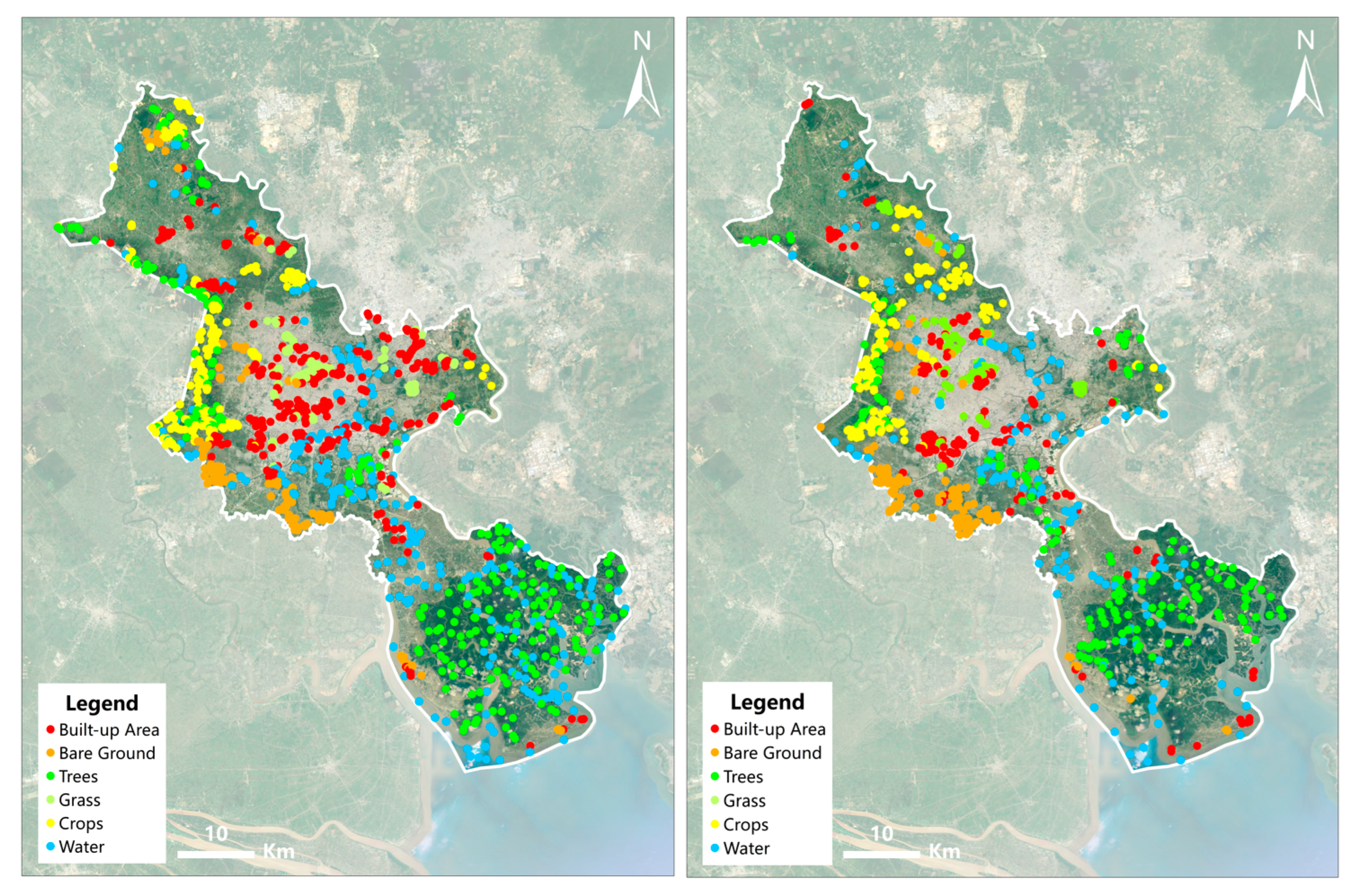
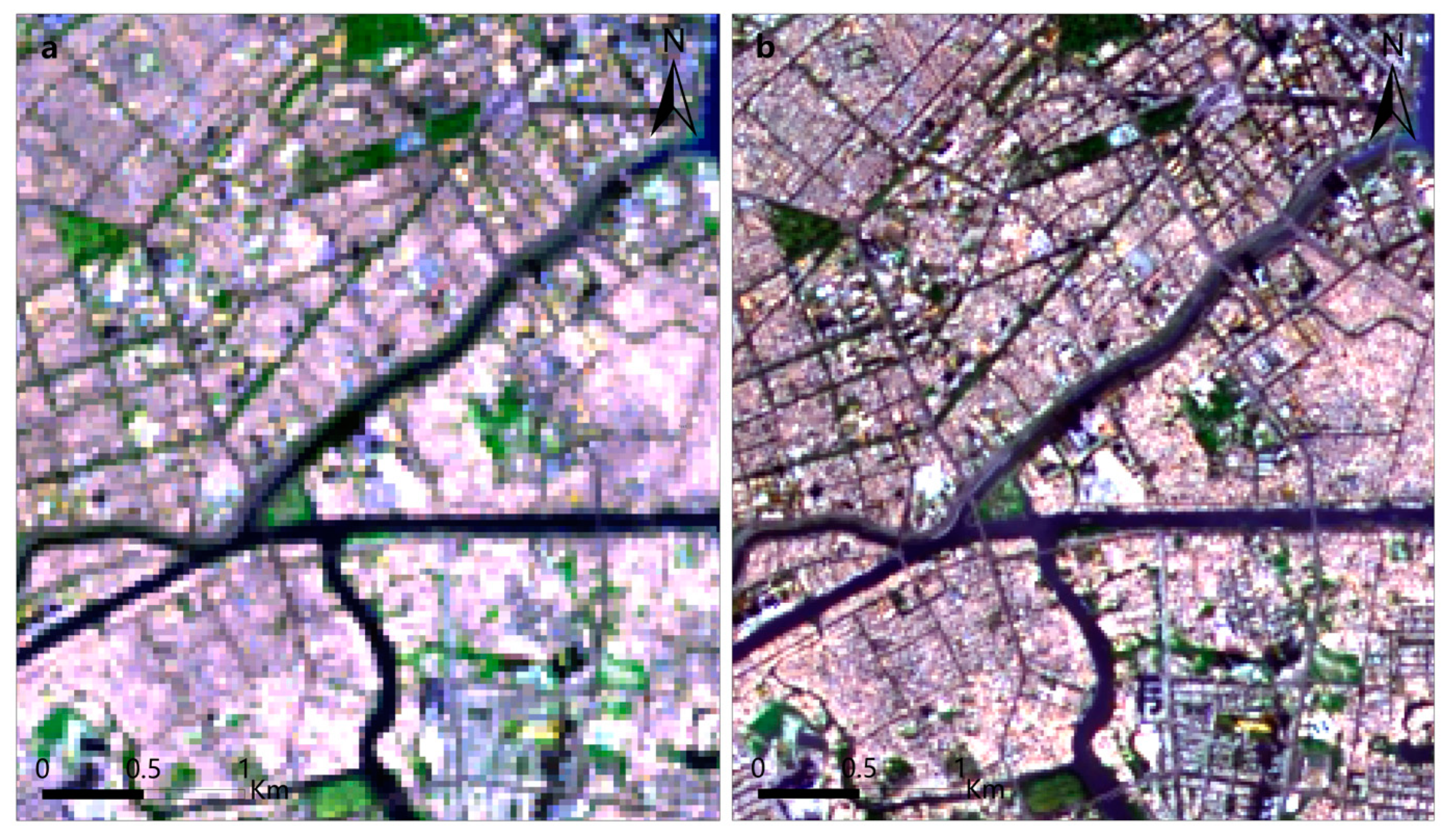

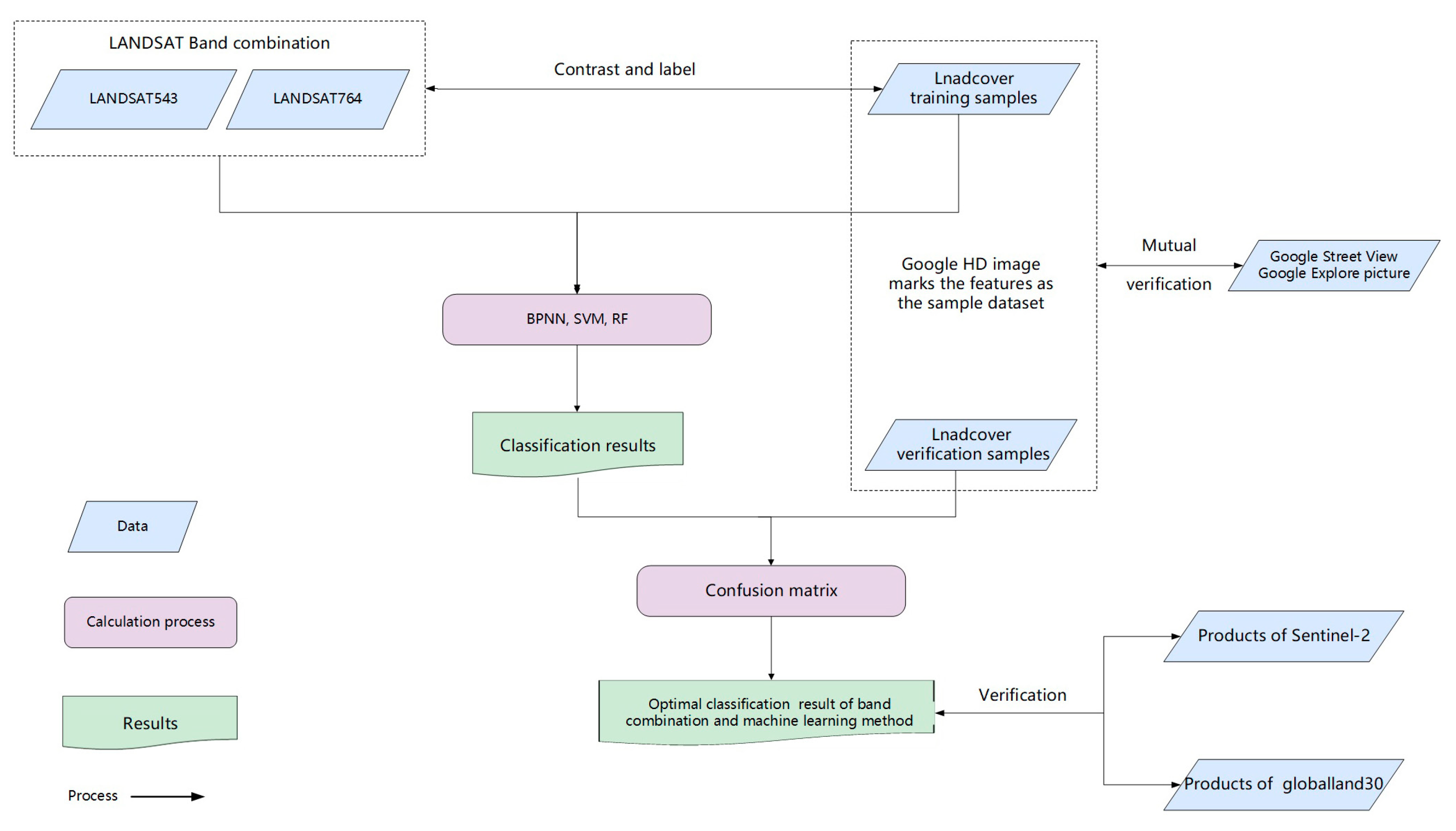
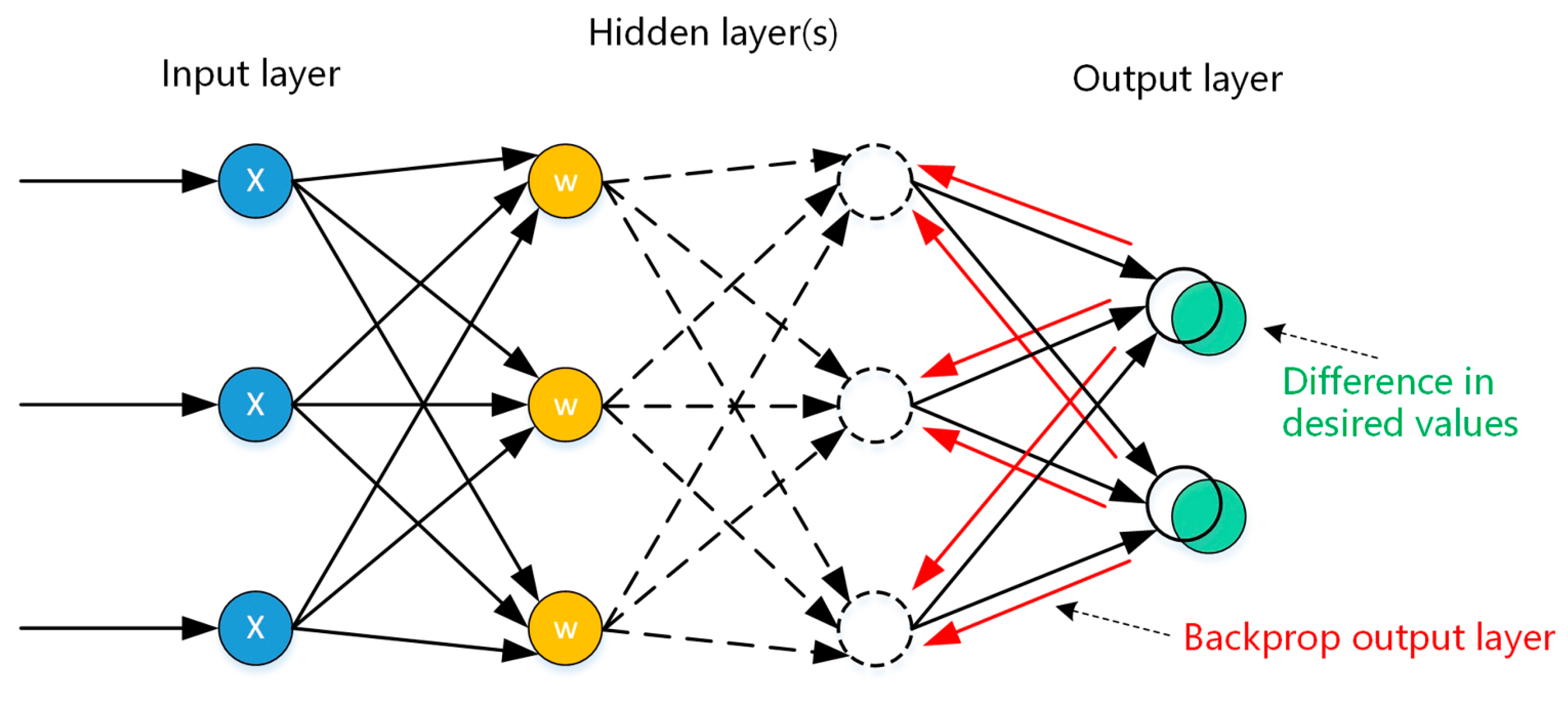
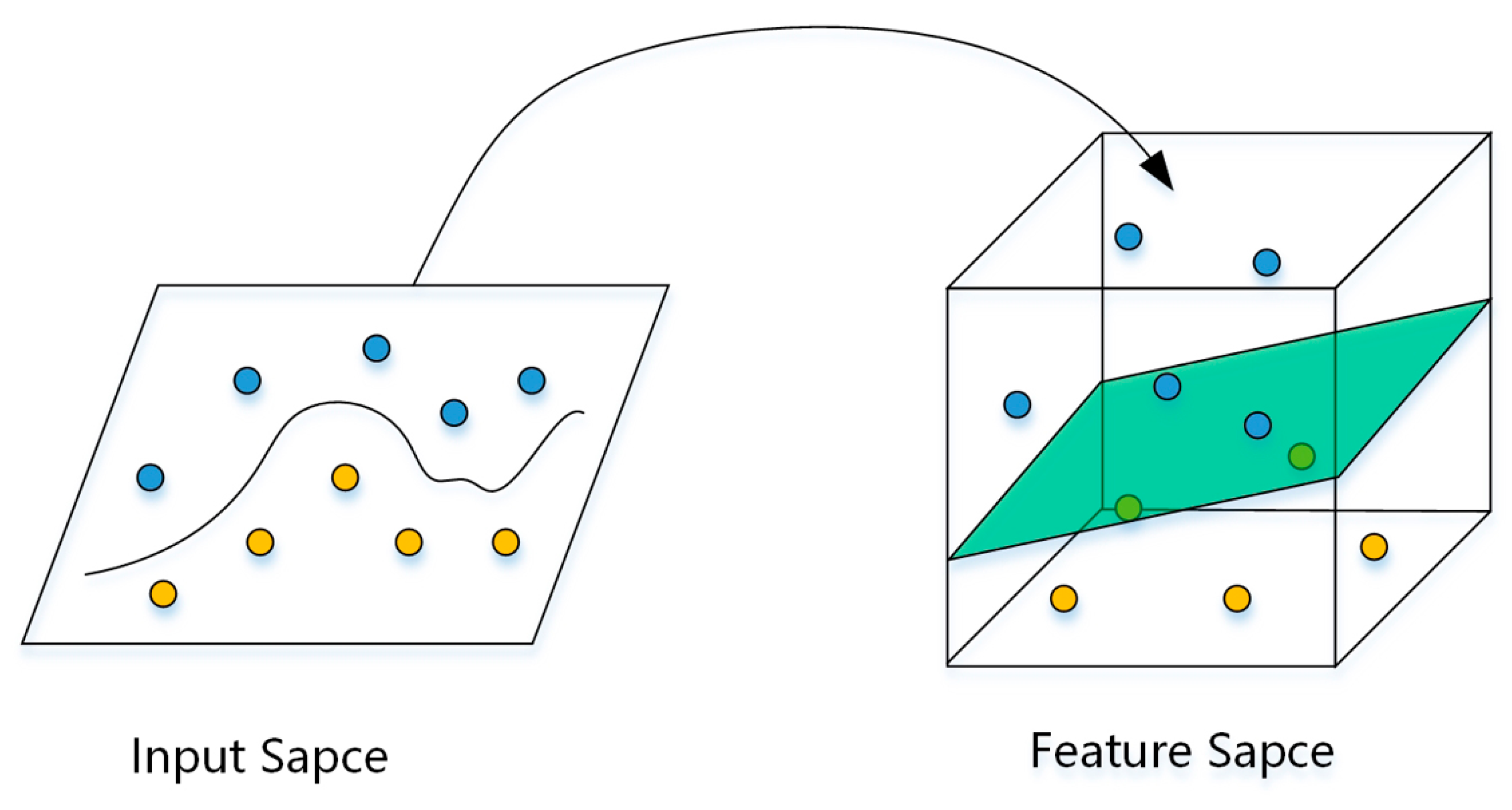
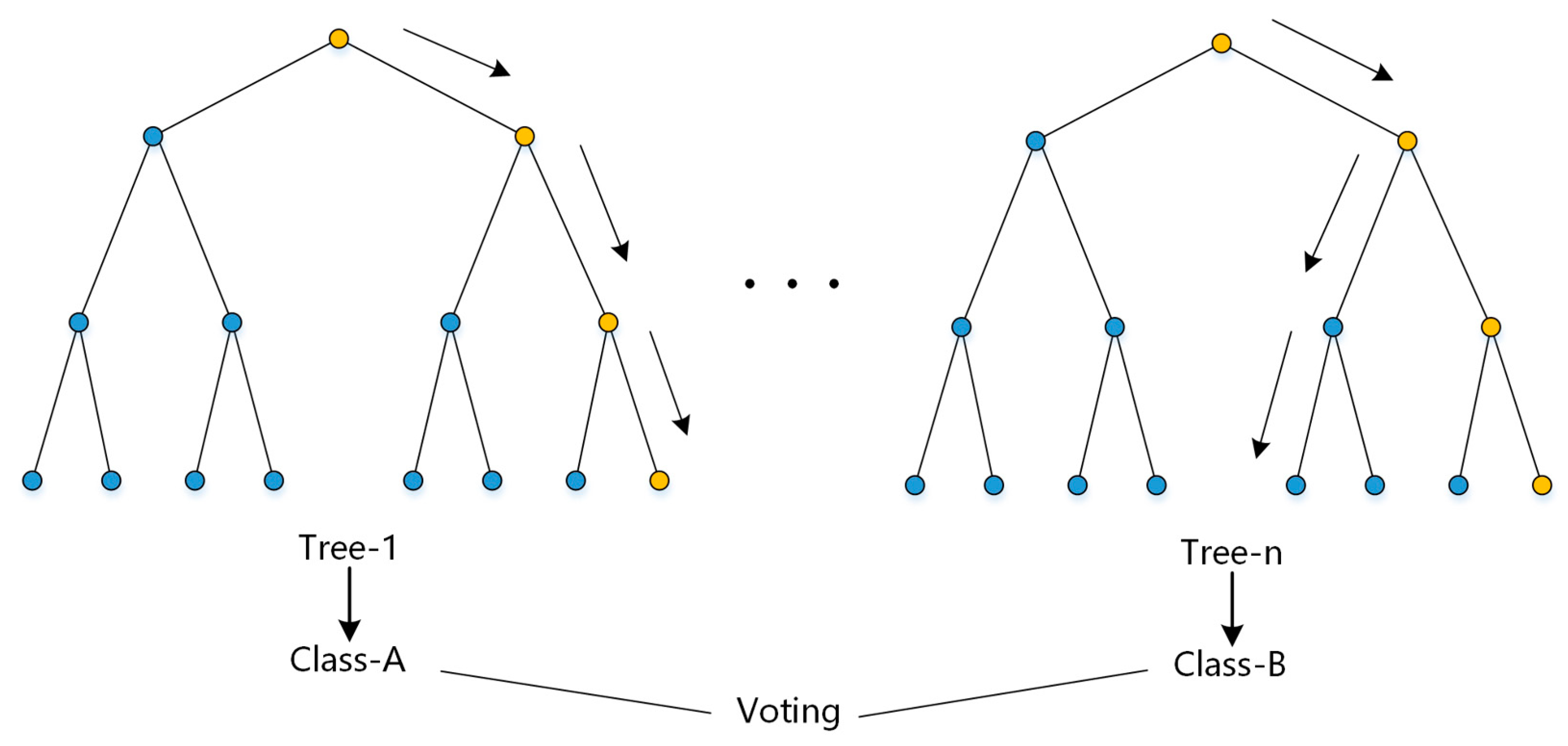
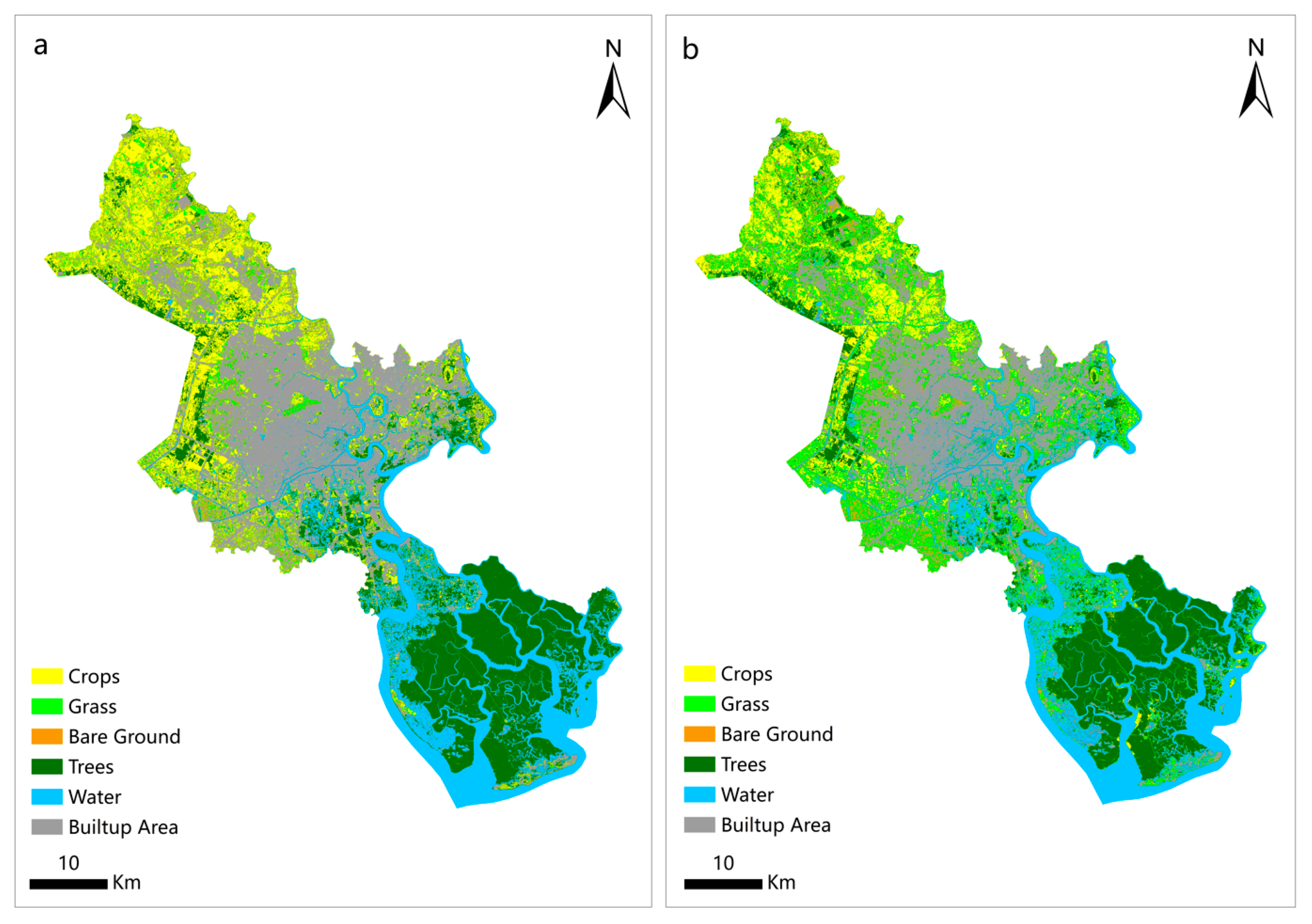
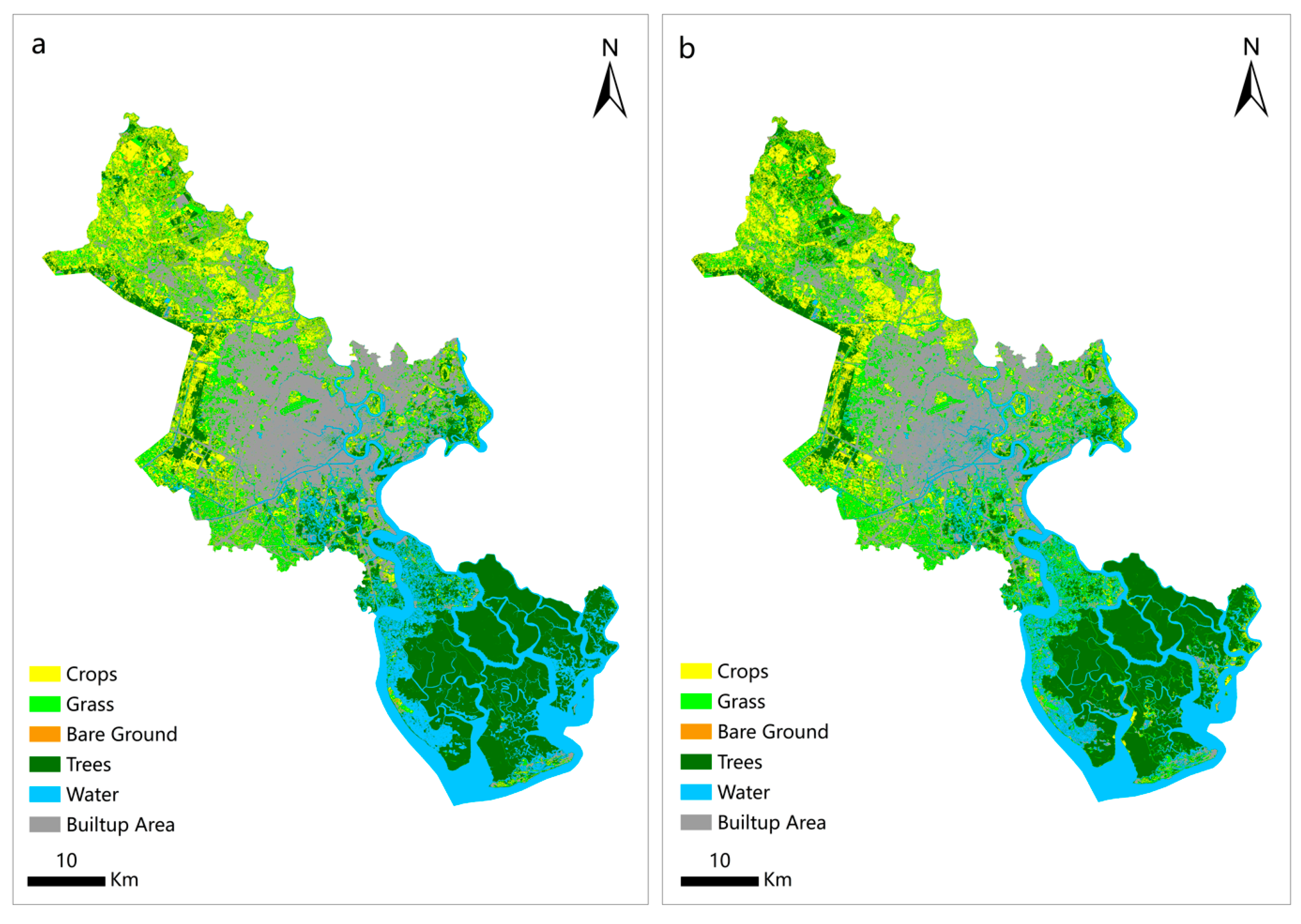
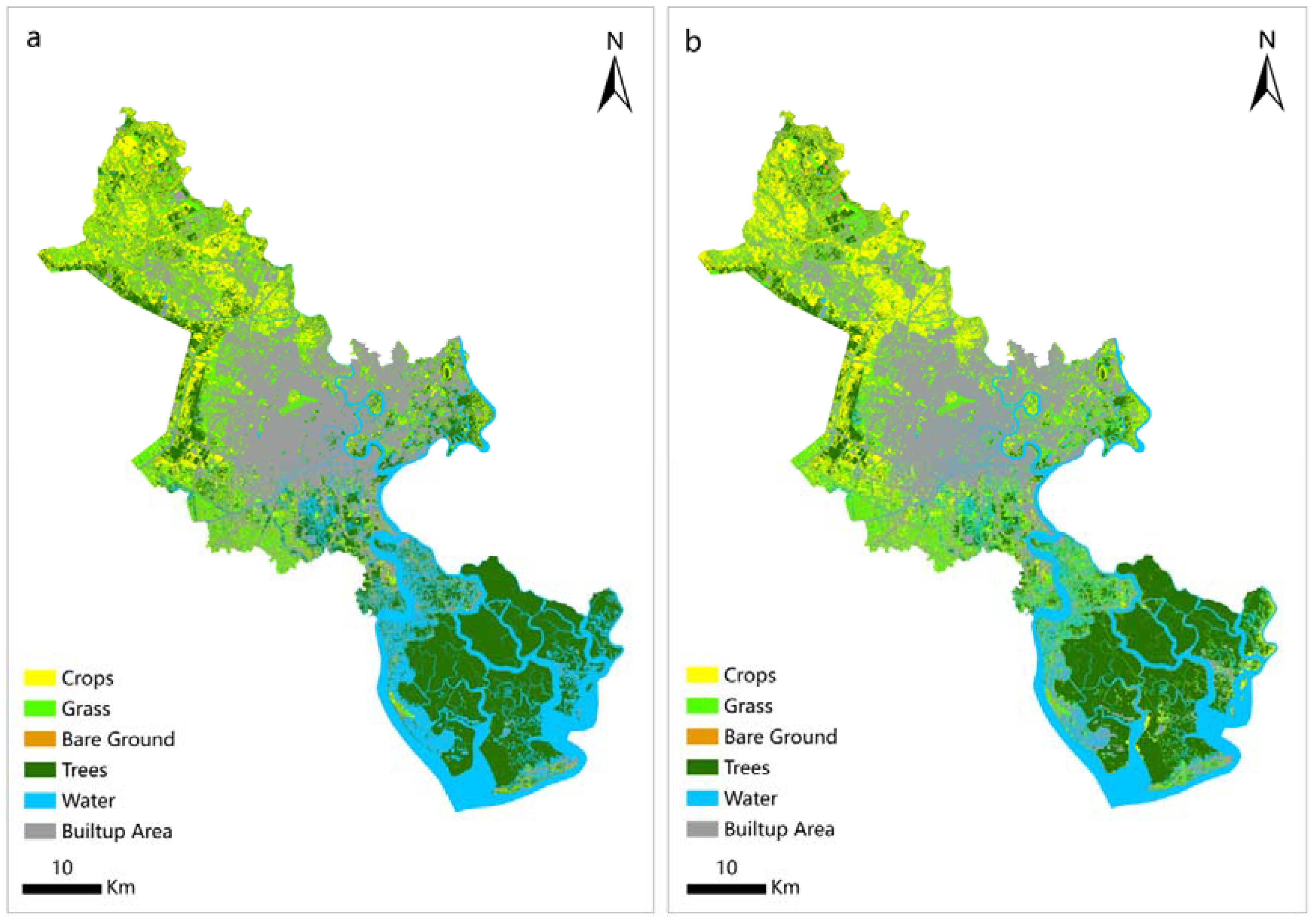
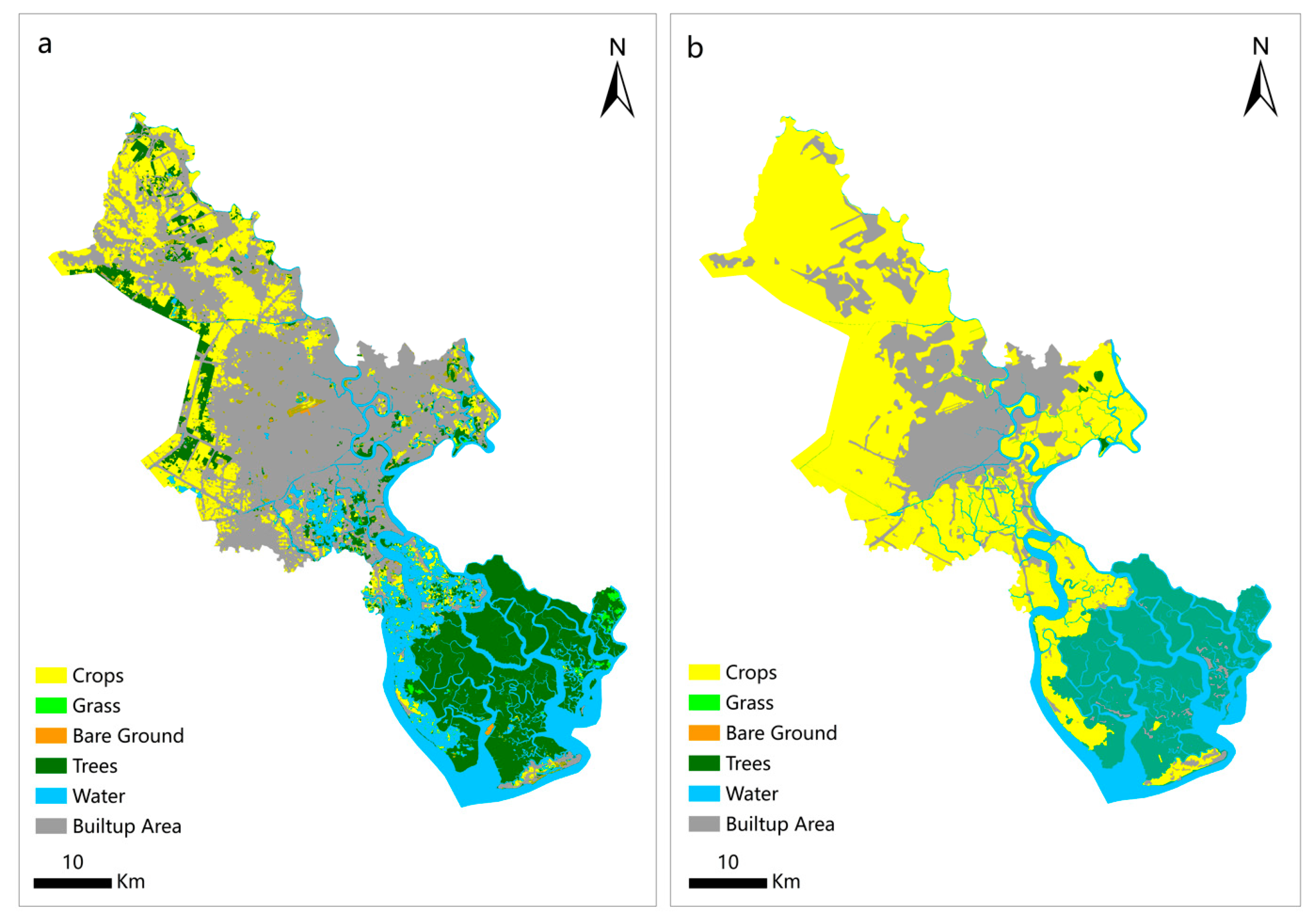
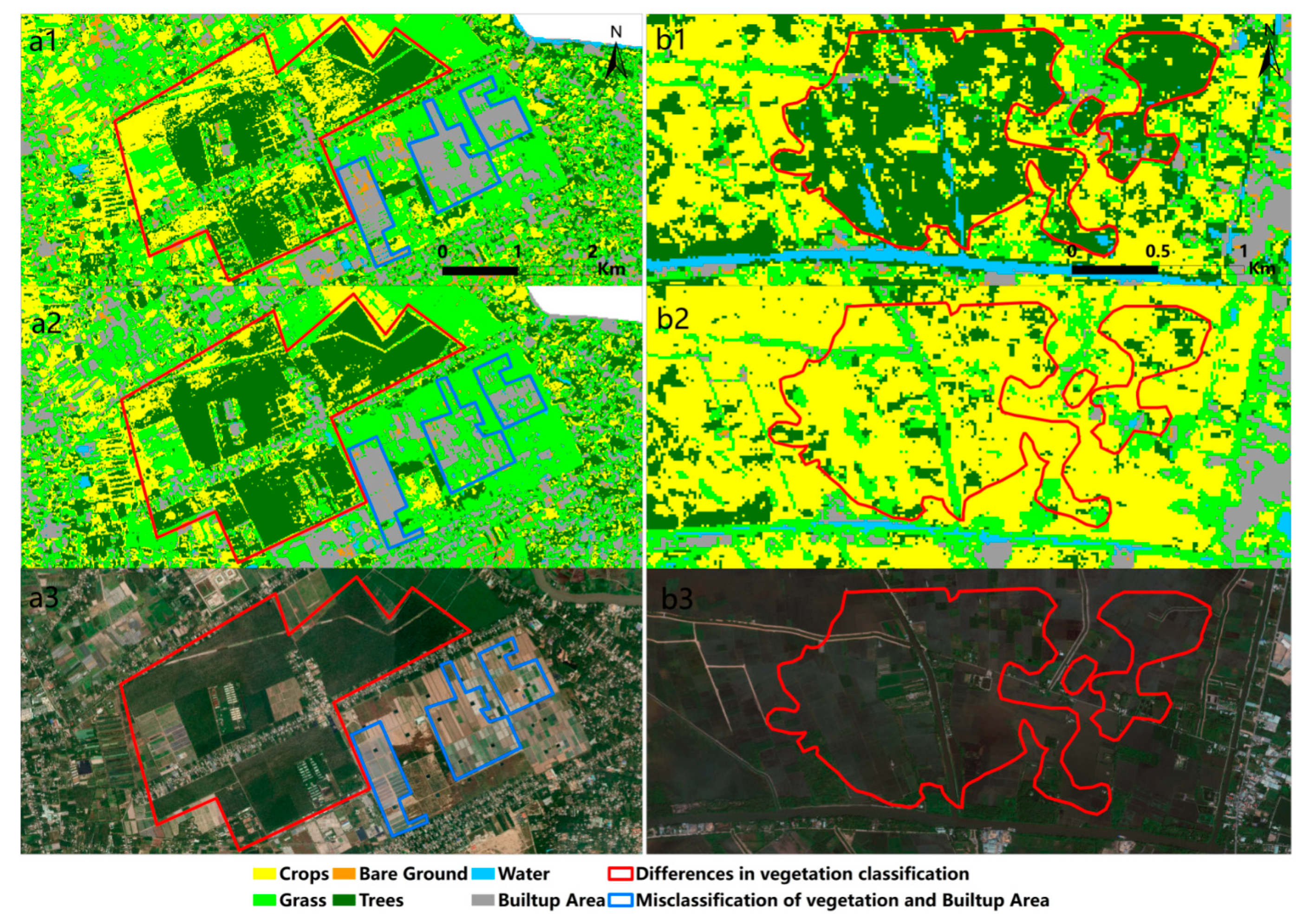
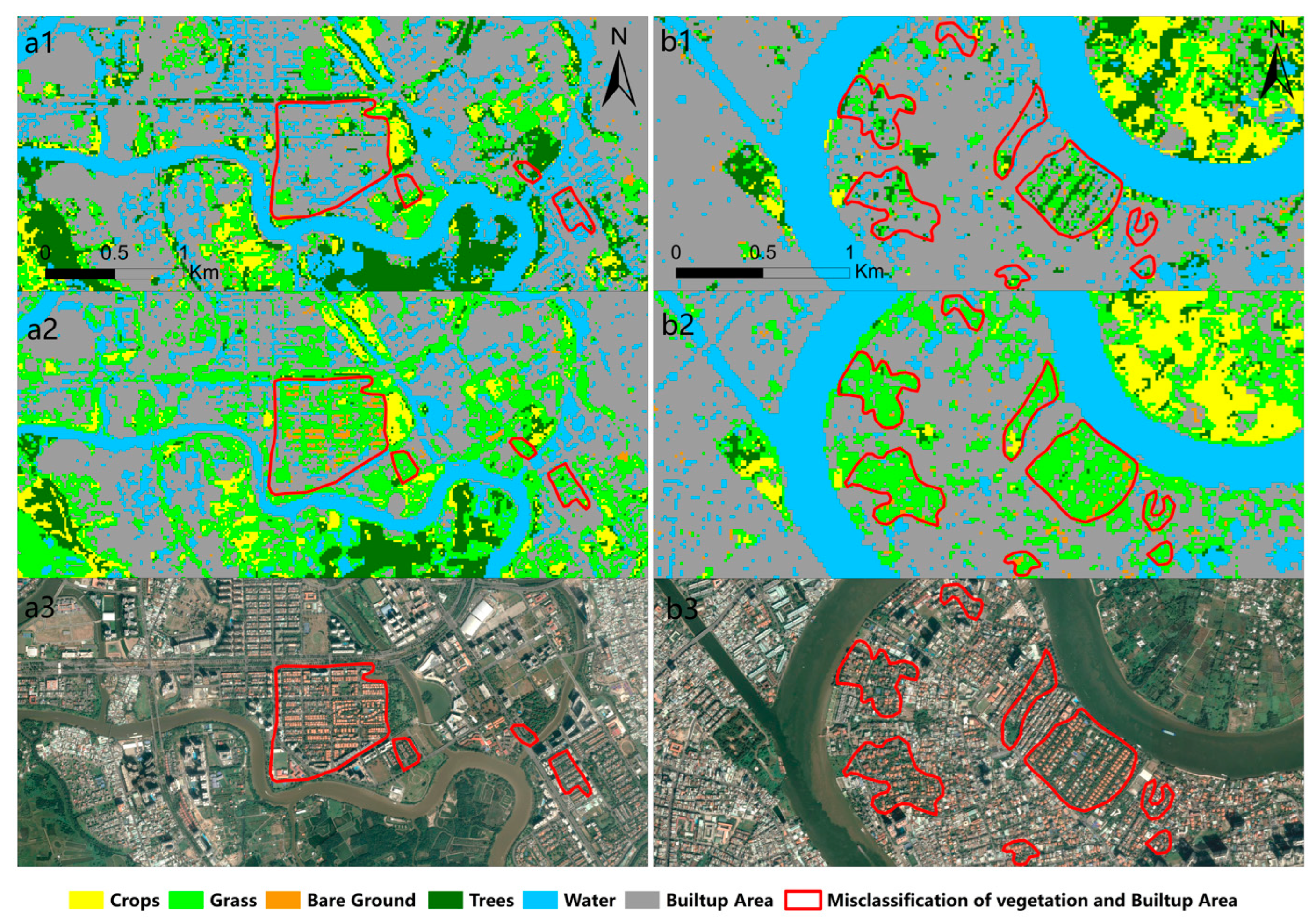
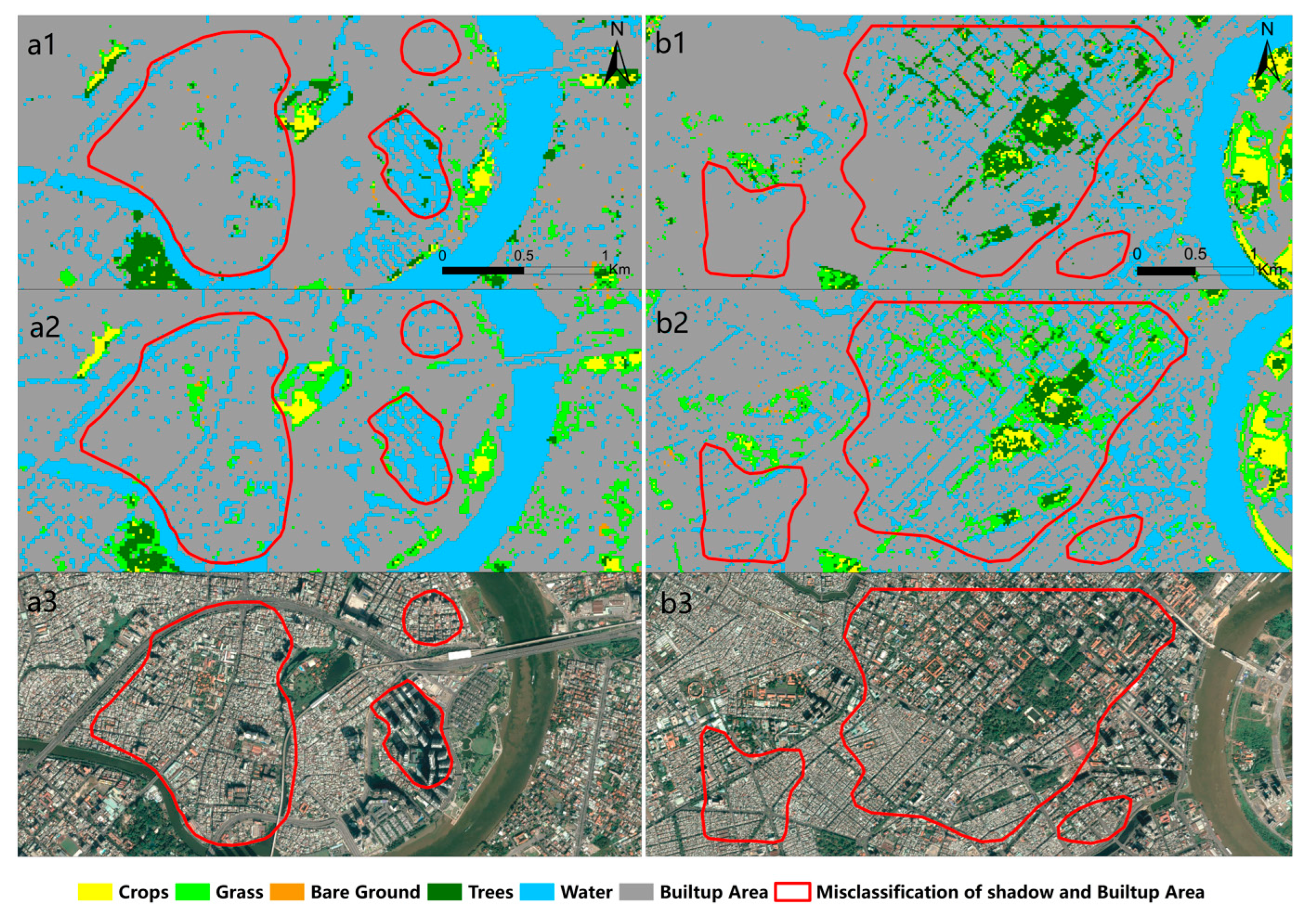
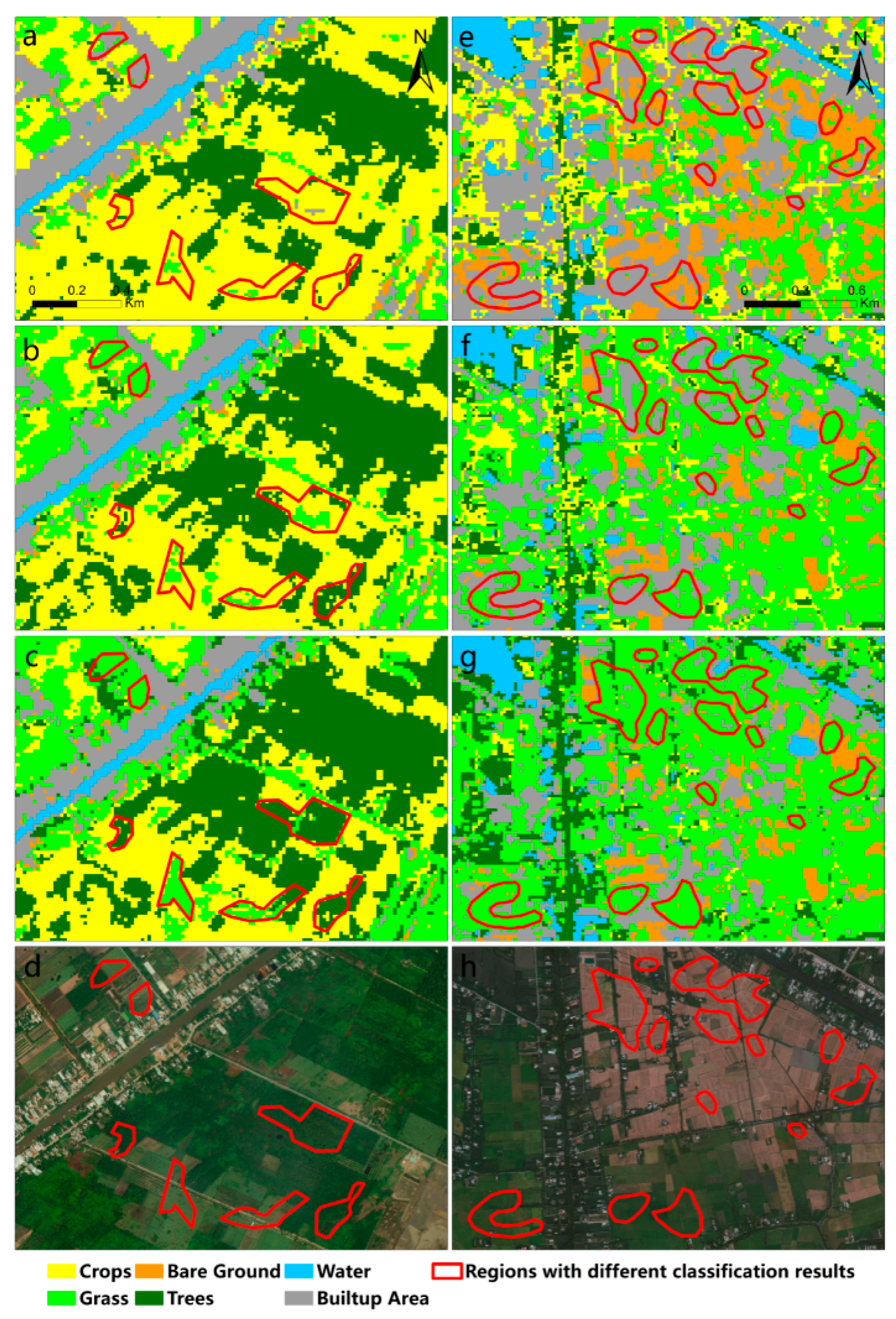
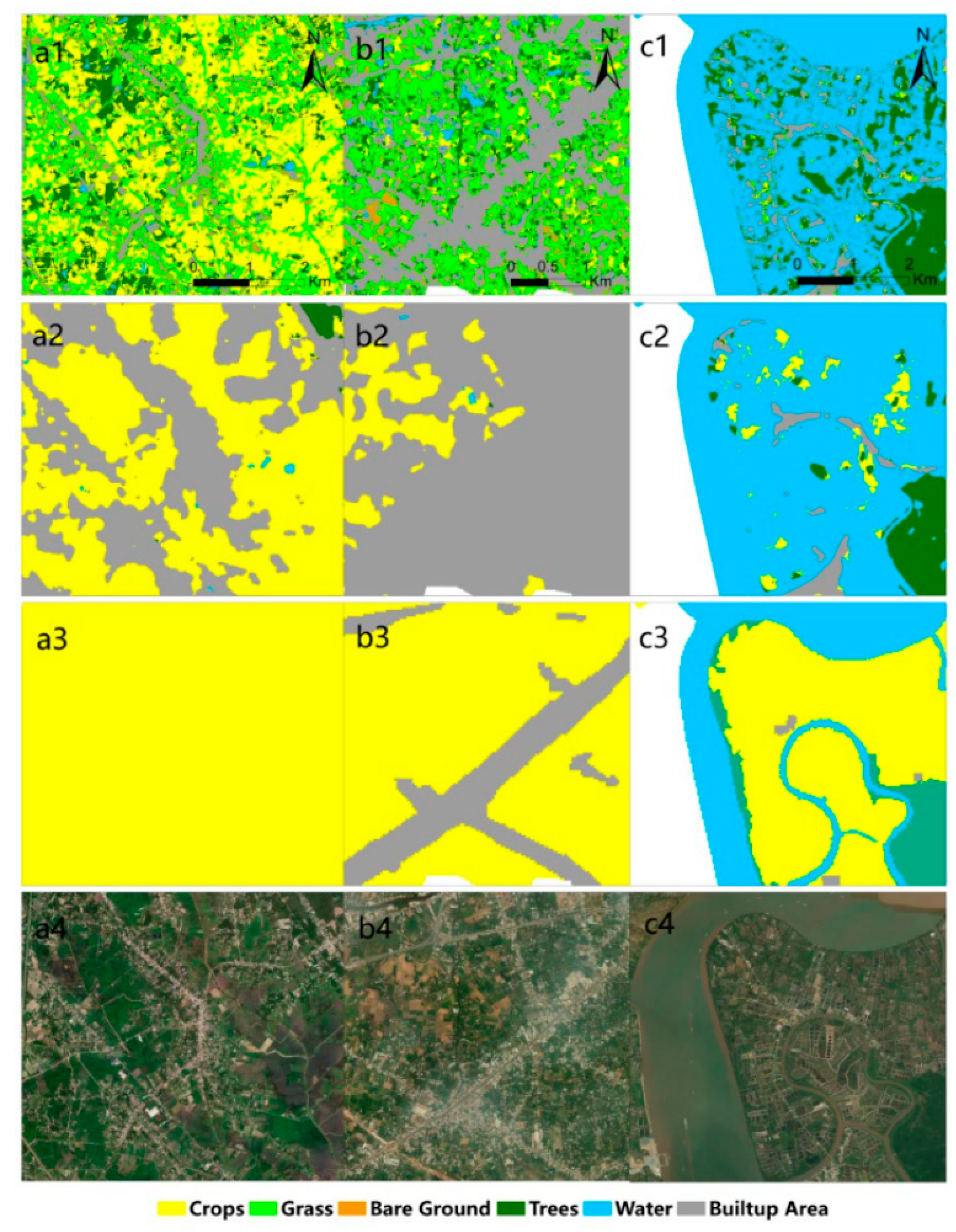
| Items | Training Samples | Validation Samples | |
|---|---|---|---|
| Classification | |||
| Built-up Area | 273 | 143 | |
| Trees | 240 | 161 | |
| Water | 236 | 143 | |
| Crops | 255 | 172 | |
| Grass | 150 | 101 | |
| Bare Ground | 202 | 145 | |
| Total | 1356 | 865 | |
| Classification | Built-Up Area | Trees | Water | Crops | Grass | Bare Ground |
|---|---|---|---|---|---|---|
| Band | 764/543 | 764/543 | 764/543 | 764/543 | 764/543 | 764/543 |
| Built-up Area | 1.98/1.99 | 1.96/1.80 | 1.98/1.98 | 1.97/1.85 | 1.80/1.89 | |
| Trees | 1.98/1.99 | 2.00/2.00 | 1.90/1.87 | 2.00/2.00 | 2.00/2.00 | |
| Water | 1.98/2.00 | 2.00/2.00 | 2.00/2.00 | 2.00/2.00 | 2.00/2.00 | |
| Crops | 1.98/1.98 | 1.90/1.87 | 2.00/2.00 | 1.81/1.84 | 2.00/2.00 | |
| Grass | 1.97/1.85 | 2.00/2.00 | 2.00/2.00 | 1.81/1.84 | 1.84/1.97 | |
| Bare Ground | 1.80/1.89 | 2.00/2.00 | 2.00/2.00 | 2.00/2.00 | 1.84/1.97 |
| Classification | Built-Up Area | Trees | Water | Crops | Grass | Bare Ground |
|---|---|---|---|---|---|---|
| Band | 764/543 | 764/543 | 764/543 | 764/543 | 764/543 | 764/543 |
| Built-Up Area | 1.99/2.00 | 1.98/1.81 | 1.99/1.99 | 1.98/1.90 | 1.91/1.91 | |
| Trees | 1.99/2.00 | 2.00/2.00 | 1.98/1.86 | 2.00/2.00 | 2.00/2.00 | |
| Water | 1.98/1.81 | 2.00/2.00 | 2.00/2.00 | 2.00/2.00 | 2.00/2.00 | |
| Crops | 1.99/1.99 | 1.98/1.86 | 2.00/2.00 | 1.86/1.92 | 2.00/2.00 | |
| Grass | 1.98/1.90 | 2.00/2.00 | 2.00/2.00 | 1.86/1.92 | 1.76/1.85 | |
| Bare Ground | 1.91/1.91 | 2.00/2.00 | 2.00/2.00 | 2.00/2.00 | 1.76/1.85 |
| Classification | Band Combination 764 | Band Combination 543 | ||||||
|---|---|---|---|---|---|---|---|---|
| Prod. Acc. (Percent) | User Acc. (Percent) | Prod. Acc. (Pixels) | User Acc. (Pixels) | Prod. Acc. (Percent) | User Acc. (Percent) | Prod. Acc. (Pixels) | User Acc. (Pixels) | |
| Crops | 99.50 | 93.88 | 399/401 | 399/425 | 93.52 | 89.29 | 375/401 | 375/420 |
| Grass | 92.07 | 95.49 | 360/391 | 360/377 | 77.24 | 95.57 | 302/391 | 302/316 |
| Bare Ground | 66.98 | 97.26 | 142/212 | 142/146 | 33.02 | 41.92 | 70/212 | 70/167 |
| Trees | 100.00 | 99.56 | 2693/2693 | 2693/2705 | 98.63 | 99.10 | 2656/2693 | 2656/2680 |
| Water | 99.86 | 100.00 | 8064/8075 | 8064/8064 | 99.78 | 99.93 | 8057/8075 | 8057/8063 |
| Built-up Area | 100.00 | 97.57 | 2209/2209 | 2209/2264 | 99.14 | 93.79 | 2190/2209 | 2190/2335 |
| OA | 99.18% | 97.63% | ||||||
| Kappa | 0.987 | 0.961 | ||||||
| Classification | Band764 | Band543 | ||||||
|---|---|---|---|---|---|---|---|---|
| Prod. Acc. (Percent) | User Acc. (Percent) | Prod. Acc. (Pixels) | User Acc. (Pixels) | Prod. Acc. (Percent) | User Acc. (Percent) | Prod. Acc. (Pixels) | User Acc. (Pixels) | |
| Crops | 96.26 | 95.54 | 386/401 | 386/404 | 92.52 | 94.64 | 371/401 | 371/392 |
| Grass | 94.63 | 98.79 | 370/391 | 370/382 | 91.56 | 95.98 | 358/391 | 358/373 |
| Bare Ground | 83.96 | 98.34 | 178/212 | 178/181 | 91.51 | 94.63 | 194/212 | 194/205 |
| Trees | 100.00 | 99.15 | 2693/2693 | 2693/2716 | 99.78 | 98.64 | 2687/2693 | 2687/2724 |
| Water | 99.84 | 99.96 | 8062/8075 | 8062/8065 | 99.67 | 99.95 | 8048/8075 | 8048/8052 |
| Built-up Area | 99.86 | 98.79 | 2206/2209 | 2206/2233 | 99.50 | 98.34 | 2198/2209 | 2198/2235 |
| OA | 99.38% | 99.11% | ||||||
| Kappa | 0.990 | 0.985 | ||||||
| Classification | Band764 | Band543 | ||||||
|---|---|---|---|---|---|---|---|---|
| Prod. Acc. (Percent) | User Acc. (Percent) | Prod. Acc. (Pixels) | User Acc. (Pixels) | Prod. Acc. (Percent) | User Acc. (Percent) | Prod. Acc. (Pixels) | User Acc. (Pixels) | |
| Crops | 95.26 | 96.22 | 382/401 | 382/397 | 94.51 | 94.28 | 379/401 | 379/402 |
| Grass | 95.40 | 95.89 | 373/391 | 373/389 | 96.68 | 95.94 | 378/391 | 378/394 |
| Bare Ground | 87.26 | 99.46 | 185/212 | 185/186 | 91.04 | 99.48 | 193/212 | 193/194 |
| Trees | 99.96 | 99.12 | 2692/2693 | 2692/2716 | 99.55 | 99.08 | 2681/2693 | 2681/2706 |
| Water | 99.81 | 100.00 | 8060/8075 | 8060/8060 | 99.39 | 99.98 | 8026/8075 | 8026/8028 |
| Built-up Area | 99.91 | 98.84 | 2207/2209 | 2207/2233 | 99.95 | 97.83 | 2208/2209 | 2208/2257 |
| OA | 99.41% | 99.17% | ||||||
| Kappa | 0.990 | 0.986 | ||||||
| Classification | RF764 | Sentinel-2 | Globalland30 |
|---|---|---|---|
| Crops | 221.74 | 344.47 | 1050.69 |
| Trees | 591.21 | 467.71 | 370.38 |
| Grass | 299.59 | 24.73 | 0.22 |
| Water | 408.62 | 408.52 | 263.40 |
| Bare Ground | 35.98 | 3.77 | 0 |
| Built-up Area | 554.29 | 862.26 | 426.75 |
| Total | 2111.45 | 2111.45 | 2111.45 |
| Classification | BPNN | SVM | RF |
|---|---|---|---|
| Crops | 174.83% | 137.12% | 100.00% |
| Trees | 44.93% | 87.48% | 100.00% |
| Grass | 123.71% | 76.57% | 100.00% |
| Water | 86.61% | 92.27% | 100.00% |
| Bare Ground | 98.78% | 101.39% | 100.00% |
| Built-up Area | 113.48% | 100.66% | 100.00% |
Disclaimer/Publisher’s Note: The statements, opinions and data contained in all publications are solely those of the individual author(s) and contributor(s) and not of MDPI and/or the editor(s). MDPI and/or the editor(s) disclaim responsibility for any injury to people or property resulting from any ideas, methods, instructions or products referred to in the content. |
© 2023 by the authors. Licensee MDPI, Basel, Switzerland. This article is an open access article distributed under the terms and conditions of the Creative Commons Attribution (CC BY) license (https://creativecommons.org/licenses/by/4.0/).
Share and Cite
Huang, C.; He, C.; Wu, Q.; Nguyen, M.; Hong, S. Classification of the Land Cover of a Megacity in ASEAN Using Two Band Combinations and Three Machine Learning Algorithms: A Case Study in Ho Chi Minh City. Sustainability 2023, 15, 6798. https://doi.org/10.3390/su15086798
Huang C, He C, Wu Q, Nguyen M, Hong S. Classification of the Land Cover of a Megacity in ASEAN Using Two Band Combinations and Three Machine Learning Algorithms: A Case Study in Ho Chi Minh City. Sustainability. 2023; 15(8):6798. https://doi.org/10.3390/su15086798
Chicago/Turabian StyleHuang, Chaoqing, Chao He, Qian Wu, MinhThu Nguyen, and Song Hong. 2023. "Classification of the Land Cover of a Megacity in ASEAN Using Two Band Combinations and Three Machine Learning Algorithms: A Case Study in Ho Chi Minh City" Sustainability 15, no. 8: 6798. https://doi.org/10.3390/su15086798
APA StyleHuang, C., He, C., Wu, Q., Nguyen, M., & Hong, S. (2023). Classification of the Land Cover of a Megacity in ASEAN Using Two Band Combinations and Three Machine Learning Algorithms: A Case Study in Ho Chi Minh City. Sustainability, 15(8), 6798. https://doi.org/10.3390/su15086798







